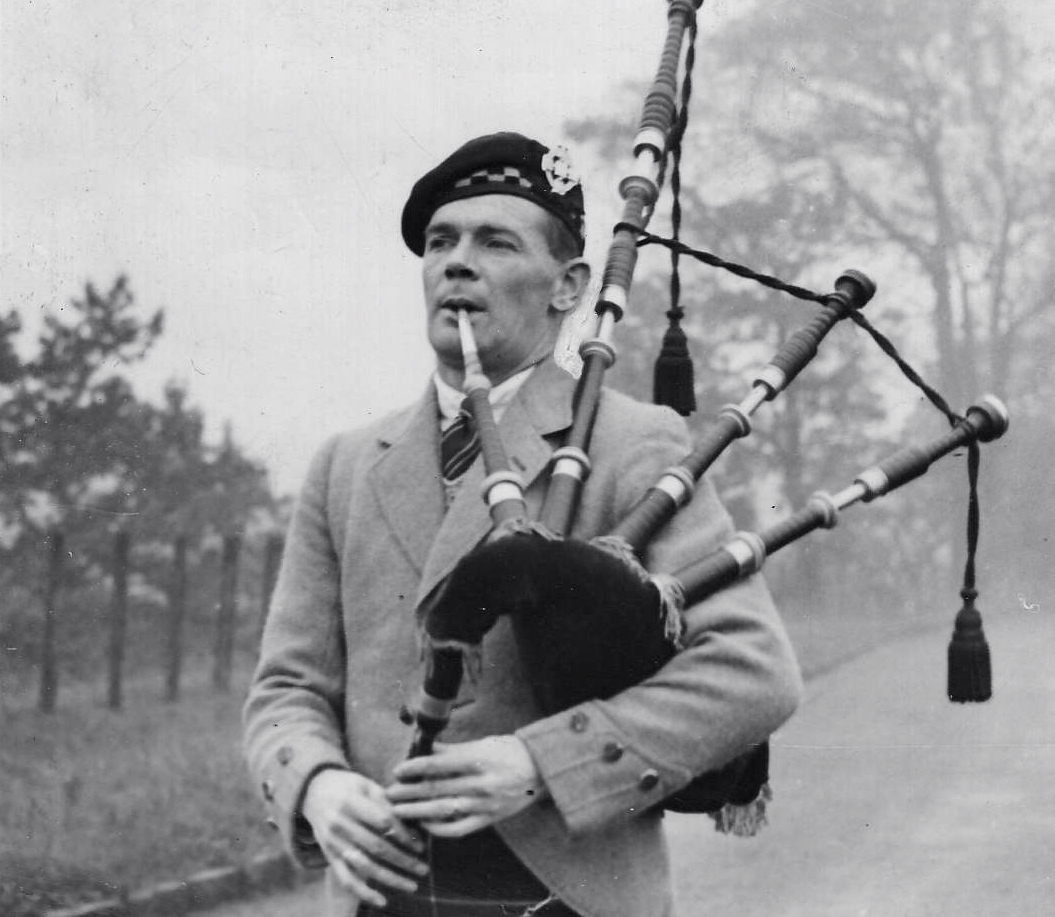
By Nicholas Taitz, Secretary of the
Scottish Piping Society of the Witwatersrand, South Africa
The debate has raged (admittedly at some times more fiercely than others) amongst piping experts for the last hundred years at least: what is the ‘correct’ way to play a leumluath, taorluath and crunluath movement in piobaireachd? The basic issue, for those unfamiliar with it, is this: Those who assert the ‘redundant’ low A theory maintain that in every grip, taorluath and crunluath, there is a ‘redundant’ low A grace note. Let’s stick to the crunluath for ease of discussion. In a crunluath with the redundant low A, we play the theme note and the movement starts in the way everyone agrees, with a low G grace note, then a D grace note onto another low G gracenote, followed by a low A gracenote (this is the controversial, ‘redundant’ low A gracenote), then followed by an E gracenote, low A gracenote, F grace note, and a low A grace note, finishing on E.
The first mystery of the redundant low A is that, somehow, although it is asserted to be a gracenote, it is not supposed to be heard like the other gracenotes forming the crunluath. A good example of this very strange proposition is the great Robert Reid’s own description of the issue where he basically states that when played at speed, one cannot hear the redundant low A in the crunluath. On the recording (below), Reid demonstrates the crunluath both slowly and quickly, both on the practice chanter. In the slow demonstration, he plays the ‘redundant’ low A gracenote distinctly and with equal length to every other grace note in the crunluath. However, when he proceeds to play at full speed, as he has been ‘playing it, all my life’, no redundant low A gracenote can be heard. Reid mentions this, and says that although we can’t hear him playing it, ‘I can assure you that I am’. He then makes the fascinating statement ‘MacDougall Gillies always said, you should not only hear it with your ear, your finger should feel it also’.
At the most basic level, how can one have a gracenote in a movement which one can’t hear? As one famous late piping master, John Burgess I think, said, ‘If you can’t hear it, it isn’t there’. If it be a gracenote, of any duration, then surely it can and must be heard.
Another mystery of the redundant low A is the belief, exemplified by Reid, that playing it is the only way to play or maintain an excellent crunluath. In the same recording, Reid discusses at one point how modern competitors (those after his time) often have poor crunuluaths, which ‘come off too light’, and with missed gracenotes. Reid says ‘they wear me out, when they can’t play a good crunluath’. He goes on to say that in his day, the likes of himself, Willie Ross, G S McLennan, Willie Gray, and others, the crunluath was played ‘correctly’ and he surmises that this was because all these great pipers were taught the movement correctly, as Reid was, with the redundant low A. As Reid puts it, he was taught correctly, and it ‘has never left’ him. (He does appear to discount the possibility that it wasn’t his teaching, but his great fingers, which accounted for this.)

So we have, effectively, a double mystery: a grace note which is said to be essential to playing great crunluaths, and yet which cannot be heard. To add to its strangeness, it is called ‘redundant’, yet it is asserted that if one is not taught and does not carefully practice this redundancy for ‘months and years’ (as Reid says), then one can’t ever hope to have a really good, cracking crunluath movement. One will always leave a good few crunlauths ‘on the ground, to be picked up’ – something Reid, GS, Willie Ross, and anyone else ‘properly taught’ would never do. Reid goes further and says that even though he’s not had a chanter nor pipes in his hands for months on end, his crunluath remains perfect because he was ‘properly taught’. From his remarks, one gets the feeling that really, if properly taught and practised, everyone should play a good crunluath just like him. He certainly seems to say so, when he says that he doesn’t think he was anything special in this regard, he was simply, once again, ‘properly taught’ by the ‘great man, John MacDougall Gillies’.
So, at least three things are strange about the redundant low A:
(1) it is said to be a grace note that is there, but is not heard;
(2) it is called ‘redundant’ when no other grace notes are so called; (3) it is said to be the secret and sine qua non to playing the crunluath movement well and with virtuosity (and as Reid said, people were always taking about how his crunluath ‘came off’ – that hasn’t changed in piping!)
I have come up with a personal theory on the matter, which again I offer without any authority, but based on logic only. Firstly, the redundant low A cannot both be a gracenote (as we normally understand a gracenote) which is played, and not be heard. This may be possible to the amateur ear, but to expert listeners every grace note, and crossing noise, is, and must, be heard.
When one plays a good crunluath at full speed, namely that as the E finger lifts to play the E gracenote, the little finger makes a preparatory and silent low A, and must do so before the E finger strikes the chanter to complete that E gracenote. If you try a crunluath in slow motion, and watch your fingers, lifting each grace note up say two inches and very slowly, you will observe your little finger ‘pop up’ right after (or at the same time as) you have lifted your E gracenote finger. In any event, your little finger must play that ‘redundant’ low A gracenote (by lifting itself yet not sounding any discernible low A gracenote) before your E finger completes the E gracenote by hitting the chanter. If not, you will not have a clean E gracenote onto low A – you will have an E grace note onto a short low G, although it may be so short it comes out as a crossing noise.
So, lifting your little finger off the chanter just after the E grace note finger has lifted, but before it comes down, is essential to a clean E to low A effect. Surely we can describe the little finger’s movement in that regard as a ‘gracenote’. After all, it fits within the time given to the E gracenote. But one wouldn’t want to call this little finger movement itself a normal gracenote, as it is not heard. So, what to call it? How about a ‘redundant’ low A gracenote?
This theory solves all the three mysteries mentioned above. First, it doesn’t involve having a gracenote being played which is not heard; hence it avoids the absurdity that I identified above. Secondly, it explains why Reid was so confident in asserting that if everyone had been taught the way he was, they would not have had such ‘light’ or inconsistent crunluaths, because the movement of the little finger mentioned above is indeed absolutely essential to a good crunluath which has a clear E grace note onto a clear low A grace note. No one would disagree with that proposition, not even the late Mr Campsie. Thirdly, it explains why it is called a ‘redundant’ gracenote – it is not heard because it is made simultaneously with the E grace note in question.
So there you have it, a plausible interpretation of the redundant low A which avoids talk of a gracenote so short one can’t really hear it, or which ‘adds depth’ (whatever that may mean), while at the same time explaining why it is called redundant and why it is so essential. While I am no MacCrimmon, Cameron or MacPherson, I would venture to suggest that this is a plausible interpretation of the controversial redundant A grac note. If this article has been an exercise in redundancy, I make no apology. We’re not called a ‘controversy’ of pipers for nothing.
*Join the discussion. Leave a comment below. Replies can be as fulsome as desired. If you have any articles on this or any other piping or pipe band topic you’d like aired email it to:
pipingpress@gmail.com




















The “redudant A” taorluath and crunluath (not grip, as you mention in the first paragraph) has its origins in the earliest records of pibroch. Whether referring to Joseph MacDonald’s descriptions of the movements (in which there is no second low G, but a half grip directly to the A; you may view such movements beginning with the second page of this document: http://www.piobaireachd.co.uk/wp-content/uploads/2012/04/Ceann-Drochaid-Mhoir.pdf), or referring to early modern typeset scores of those such as Angus MacKay (where you will see taoluaths and crunluaths written in compound time with low A melody after the initial grips; take a look here: http://www.altpibroch.com/PiobSources/AngusMacKaybook/duke_of_perths_march.pdf), what you are talking about is the most ancient way in which cruns and taors were performed.
It was only after Piobaireachd Society started publishing them differently that the controversy as such began. There was no “controversy” until that editorial decision was made.
Now, if you would like to understand the reasons behind such editorial decisions, David Murray is still around to contact, and William Donaldson’s history is available on line.
Piobaireachd would almost certainly have become a lost art by now if it were not for the hesterical reactions of academics.
It can be heard. Listen to Willie MacCallum’s taorluath.